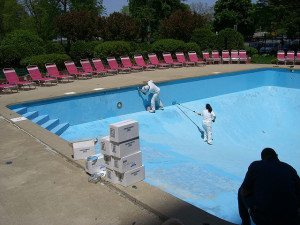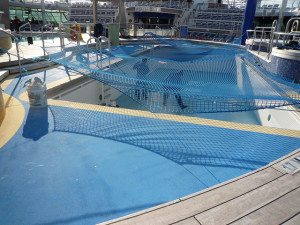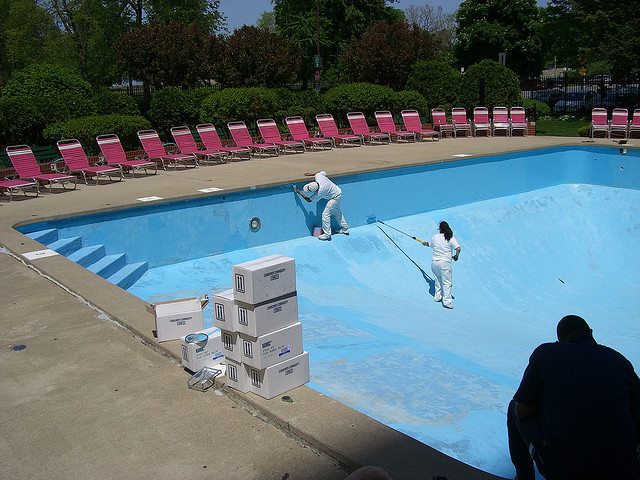How to Paint an Inground Swimming Pool
 If you wish your pool to last, it is important that you maintain it well. Maintenance of inground pools is a multilevel task and all phases are important, from regular cleaning to fixing cracks and changing filtering systems. A well-chosen and applied paint it is the very foundation that will make maintenance easier and your pool more durable. Here is how to paint your pool, both the first time and every other that will eventually follow.
If you wish your pool to last, it is important that you maintain it well. Maintenance of inground pools is a multilevel task and all phases are important, from regular cleaning to fixing cracks and changing filtering systems. A well-chosen and applied paint it is the very foundation that will make maintenance easier and your pool more durable. Here is how to paint your pool, both the first time and every other that will eventually follow.
Choice of Paint
Basically, there are three possible choices when it comes to pool paint. Acrylic paint is the most affordable and compatible with any inground pool service. If you have a limited budget and opt for this type of paint you can expect it to last for two to three years. Next, there is chlorinated rubber-based paint, more expensive and more durable. Applying this paint will keep your pool walls and bottom safe for four years. Lastly, if the budget allows it, opting for epoxy paint, extremely durable and resistant, will let you forget about repainting the pool for up to a decade.
Paint Limitations
When you are painting a swimming pool, before making a final choice of paint make sure you are absolutely certain what type the original paint was. The reason why this is so important is that rubber based paint and epoxy paint can be applied solely to the surfaces that were originally painted using the same type of paint. You cannot mix them under any circumstances. If there is no way of determining the original paint, go with acrylic paint, it can be applied to any pre-painted surface.
Pool Preparation
 The success of the entire painting process very much depends on how well the pool was prepared before the actual painting took place. Therefore, make sure you allow yourself a week of preparation time in order to be certain that all preparatory tasks have been completed. First, drain the pool, then remove all debris from the bottom and check for any cracks in the bottom and the walls and fix them. Lastly, rinse it with TSP to make sure all acid and grease was remove. Lastly, unless you plan to use acrylic paint, which can be used immediately, let the pool dry for three to five days before repainting it.
The success of the entire painting process very much depends on how well the pool was prepared before the actual painting took place. Therefore, make sure you allow yourself a week of preparation time in order to be certain that all preparatory tasks have been completed. First, drain the pool, then remove all debris from the bottom and check for any cracks in the bottom and the walls and fix them. Lastly, rinse it with TSP to make sure all acid and grease was remove. Lastly, unless you plan to use acrylic paint, which can be used immediately, let the pool dry for three to five days before repainting it.
Painting Process
Schedule the painting when the weather forecast promises at least seven days of dry and sunny weather. In a recent conversation with reputed suppliers of swimming pool paint, it was brought to my attention that applying paint should start at the deep end and gradually continue towards the shallow part of the pool. Of course, only after the paint was thoroughly mixed for at least a couple of minutes.
It is recommended that at least two coats of paint are applied for longer durability. Allow several hours of drying time before applying the second or third layer of paint. If you applied epoxy or rubber based paint, wait for at least five days before you refill the pool. In case of acrylic paint three days would suffice.
You should also make sure to pick a proper filtering system, so as to preserve the new outlook of your repainted pool. Regardless of the paint you choose, following all the necessary steps in the prescribed order is what will ensure that the painting process is successful and as long lasting as possible.
Author: If one thing is true about Lillian Connors, her mind is utterly curious. That’s why she can’t resist the urge to embark on a myriad of home improvement projects and spread the word about them. She cherishes the notion that sustainable housing and gardening will not only make us far less dependent on others regarding the dwellings we inhabit and what we eat, but also contribute to our planet being a better place to live on.
You can check her out on Twitter and LinkedIn.


This post is really invaluable. Every painter should read this. Thanks for the post.